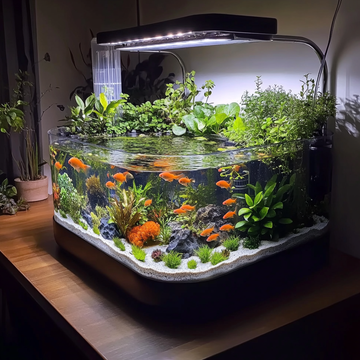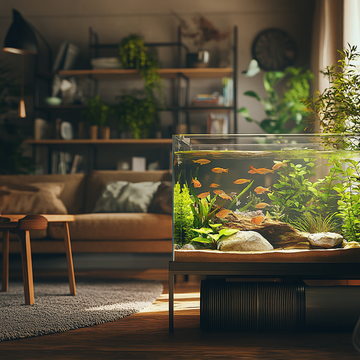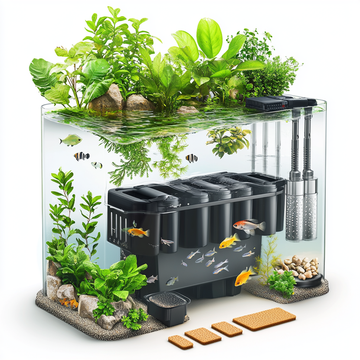At G.Valkyria, we know that your aquarium is more than just a decoration; it is an ecosystem full of life and beauty that deserves the best care 🏞️💙. Whether you are a beginner or an experienced aquarist, understanding and monitoring water parameters is essential to keeping your fish and plants in tip-top shape. In this article, we will explore in depth the different parameters you should monitor, the importance of water cycling, and how nitrites and nitrates are generated. Join us on this journey to a healthy and vibrant aquarium! 🌟
Why is it crucial to measure water parameters? 🧐
Water is your fish's home, and its quality directly affects their health and well-being. Measuring and monitoring water parameters allows you to:
- Prevent Diseases : Detect imbalances that can cause stress or disease in your fish.
- Promote Plant Growth : Ensure conditions are ideal for the growth of aquatic plants.
- Maintain a Balanced Ecosystem : Ensure beneficial bacteria thrive and keep the nitrogen cycle running.
- Avoid Losses : Reduce the risk of sudden mortality in your aquarium.
Main Water Parameters to Control 📊
1. pH (Hydrogen Potential) 🧪
- What it is : Measures the acidity or alkalinity of water on a scale of 0 to 14.
- Importance : Different species require different pH levels. Improper pH can cause stress and disease.
-
Ideal Range :
- Community Aquariums : pH between 6.5 and 7.5 .
- Specific Species : Research the specific needs of your fish to determine the pH they require.
- How to Measure : Use pH test kits or digital meters.
2. Temperature 🌡️
- Importance : Fish are ectotherms and depend on water temperature to regulate their metabolic processes.
-
Ideal Range :
- Tropical Aquariums : Between 24°C and 27°C .
- Cold Water Aquariums : Between 18°C and 22°C .
- How to Measure : Submersible or adhesive thermometers on the outside of the aquarium.
- G.Valkyria Tip : Avoid sudden temperature fluctuations; they can be fatal for your fish.
3. Water Hardness (GH and KH) 💎
-
GH (General Hardness) :
- What it is : A measure of minerals such as calcium and magnesium.
- Importance : Affects bone health and fish reproduction.
- Ideal Range : Depends on the species; generally ranges are between 4° and 12° dGH .
-
KH (Carbonate Hardness) :
- What it is : Water's ability to maintain stable pH.
- Importance : Adequate KH prevents pH fluctuations.
- Ideal Range : Between 3° and 8° dKH .
4. Ammonia (NH3/NH4) 🟡
- What it is : Product of fish waste and decomposing organic matter.
- Importance : Highly toxic even at low concentrations.
- Safe Level : 0 ppm (parts per million).
- How to Measure It : Specific test kits for ammonia.
5. Nitrites (NO2-) 🟠
- What it is : Result of the conversion of ammonia by nitrifying bacteria.
- Importance : Also toxic to fish.
- Safe Level : 0 ppm .
- How to Measure It : Nitrite Test Kits
6. Nitrates (NO3-) 🔴
- What it is : Final product of the nitrogen cycle.
- Importance : Less toxic, but high levels may be harmful.
- Safe Level : Less than 20 ppm for freshwater aquariums.
- How to Control : Regular water changes and plants that absorb nitrates.
7. Dissolved Oxygen (O2) 🌬️
- Importance : Essential for fish respiration and beneficial bacteria.
- How to Improve It : Ensure good circulation and gas exchange surface.
- How to Measure It : Dissolved Oxygen Meters.
The Nitrogen Cycle: The Heart of the Aquarium 🌀
What is the Nitrogen Cycle?
It is a biological process in which beneficial bacteria convert toxic waste into less harmful compounds:
- Ammonia (NH3/NH4+) : Fish waste and food scraps produce ammonia.
- Nitrites (NO2-) : Nitrosomonas bacteria convert ammonia into nitrites.
- Nitrates (NO3-) : Nitrobacter bacteria convert nitrites into nitrates.
- Nitrate Removal : Through water changes and plant absorption.
Importance of the Nitrogen Cycle
- Prevents Toxicity : Prevents the accumulation of toxic substances.
- Ecosystem Stability : Maintains a healthy environment for fish and plants.
- Health Indicator : High levels of ammonia or nitrites indicate problems in the aquarium.
How to Cycle Your First-Time Aquarium
- Cycling Without Fish : Add a source of ammonia (e.g. fish food) and allow the bacteria to establish.
- Monitor : Measure ammonia, nitrites and nitrates regularly.
- Patience : The process can take 4 to 6 weeks .
- G.Valkyria Tip : Do not introduce fish until ammonia and nitrites are at 0 ppm .
Methods and Tools for Measuring Water Parameters 🛠️
1. Liquid Test Kits
- Advantages : Accuracy and ability to measure multiple parameters.
- Usage : Follow manufacturer's instructions for accurate readings.
2. Test Strips
- Advantages : Quick and easy to use.
- Disadvantages : Less accurate than liquid kits.
- G.Valkyria Tip : Use these for quick checks, but rely on liquid kits for more accuracy.
3. Digital Meters
- pH and Temperature : Specific meters that provide instant readings.
- Dissolved Oxygen and Conductivity : For more advanced aquarists.
4. Applications and Registrations
- Monitor : Keep track of your measurements to spot trends.
- Useful Apps : There are apps that help you record and analyze data.
Tips for Maintaining Stable Parameters 📝
- Regular Water Changes : Perform partial changes of 20-25% weekly or bi-weekly.
- Don't Overfeed : Excess food increases waste.
- Don't Overstock : Too many fish generate more ammonia than the system can handle.
- Proper Filtration : Ensure the filter is appropriate for the size of your aquarium.
- Natural Plants : They help absorb nitrates and improve water quality.
- Beware of Chemical Products : Use specific products for aquariums and follow the instructions.
Measuring and monitoring water parameters in your freshwater aquarium is essential to creating and maintaining a healthy and thriving environment for your fish and plants 🐠🌿. Understanding the nitrogen cycle and how different parameters affect it allows you to make informed decisions and act quickly on any imbalances.
At G.Valkyria, we are committed to the well-being of your aquatic pets and are here to advise you every step of the way. Thank you for trusting us with the care of your aquarium! 🌊✨
Share your experience!
Do you have any tips or experiences on how you manage water parameters in your aquarium? 🐟💬 Share with us in the comments and let's help other enthusiasts create healthy and successful aquariums!
We hope you find this article helpful! If you have any questions or need personalized advice, please feel free to contact us. At G.Valkyria, we are here for you and your wonderful aquatic pets 🐠💕








